MITSUBISHI LANCER EVOLUTION IX 2005 Repair Manual
Manufacturer: MITSUBISHI, Model Year: 2005, Model line: LANCER EVOLUTION IX, Model: MITSUBISHI LANCER EVOLUTION IX 2005Pages: 364, PDF Size: 14.38 MB
Page 51 of 364
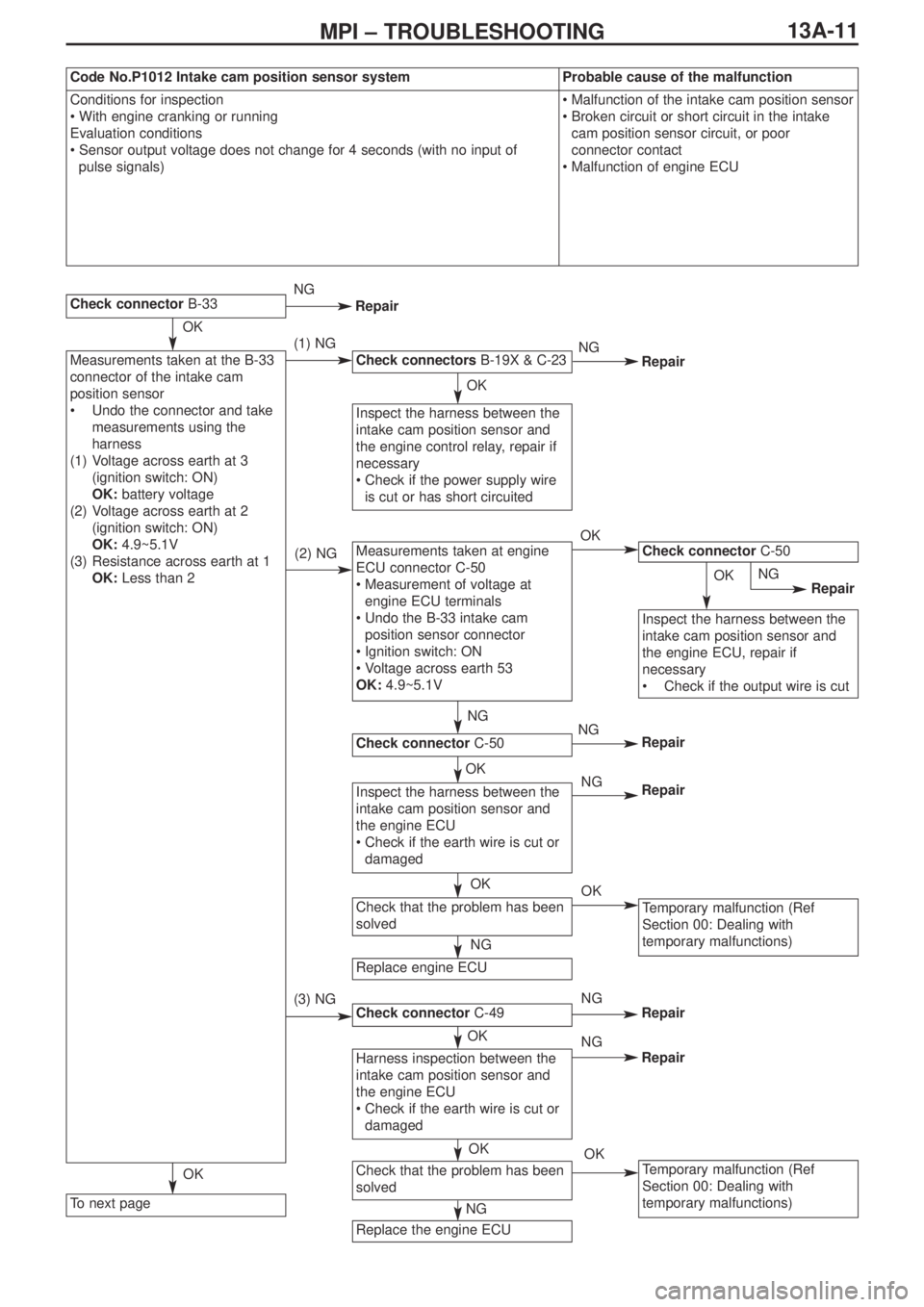
13A-11MPI – TROUBLESHOOTING
Check connectorB-33
To next page
Check connectorsB-19X & C-23
Inspect the harness between the
intake cam position sensor and
the engine control relay, repair if
necessary
•Check if the power supply wire
is cut or has short circuited
Measurements taken at engine
ECU connector C-50
•Measurement of voltage at
engine ECU terminals
•Undo the B-33 intake cam
position sensor connector
•Ignition switch: ON
•Voltage across earth 53
OK:4.9~5.1V
Check connectorC-50
Check connectorC-49
Inspect the harness between the
intake cam position sensor and
the engine ECU
•Check if the earth wire is cut or
damaged
Harness inspection between the
intake cam position sensor and
the engine ECU
•Check if the earth wire is cut or
damaged
Replace the engine ECU
Replace engine ECU
Check that the problem has been
solved
Check that the problem has been
solved
Check connector C-50
Inspect the harness between the
intake cam position sensor and
the engine ECU, repair if
necessary
•Check if the output wire is cut
Temporary malfunction (Ref
Section 00: Dealing with
temporary malfunctions)
Temporary malfunction (Ref
Section 00: Dealing with
temporary malfunctions)
Measurements taken at the B-33
connector of the intake cam
position sensor
•Undo the connector and take
measurements using the
harness
(1) Voltage across earth at 3
(ignition switch: ON)
OK:battery voltage
(2) Voltage across earth at 2
(ignition switch: ON)
OK:4.9~5.1V
(3) Resistance across earth at 1
OK:Less than 2Ω
Code No.P1012 Intake cam position sensor systemProbable cause of the malfunction
Conditions for inspection
• With engine cranking or running
Evaluation conditions
• Sensor output voltage does not change for 4 seconds (with no input of
pulse signals)•Malfunction of the intake cam position sensor
•Broken circuit or short circuit in the intake
cam position sensor circuit, or poor
connector contact
•Malfunction of engine ECU
OK
OK
NG
(1) NG
(2) NG
(3) NG
OK
NG
NG
OK
OK
OK
NG
NG
NG
OK
NG
OK OK
NG
NG
OK
OKNG
Repair
Repair
Repair
Repair
Repair
Repair
Repair
Page 52 of 364
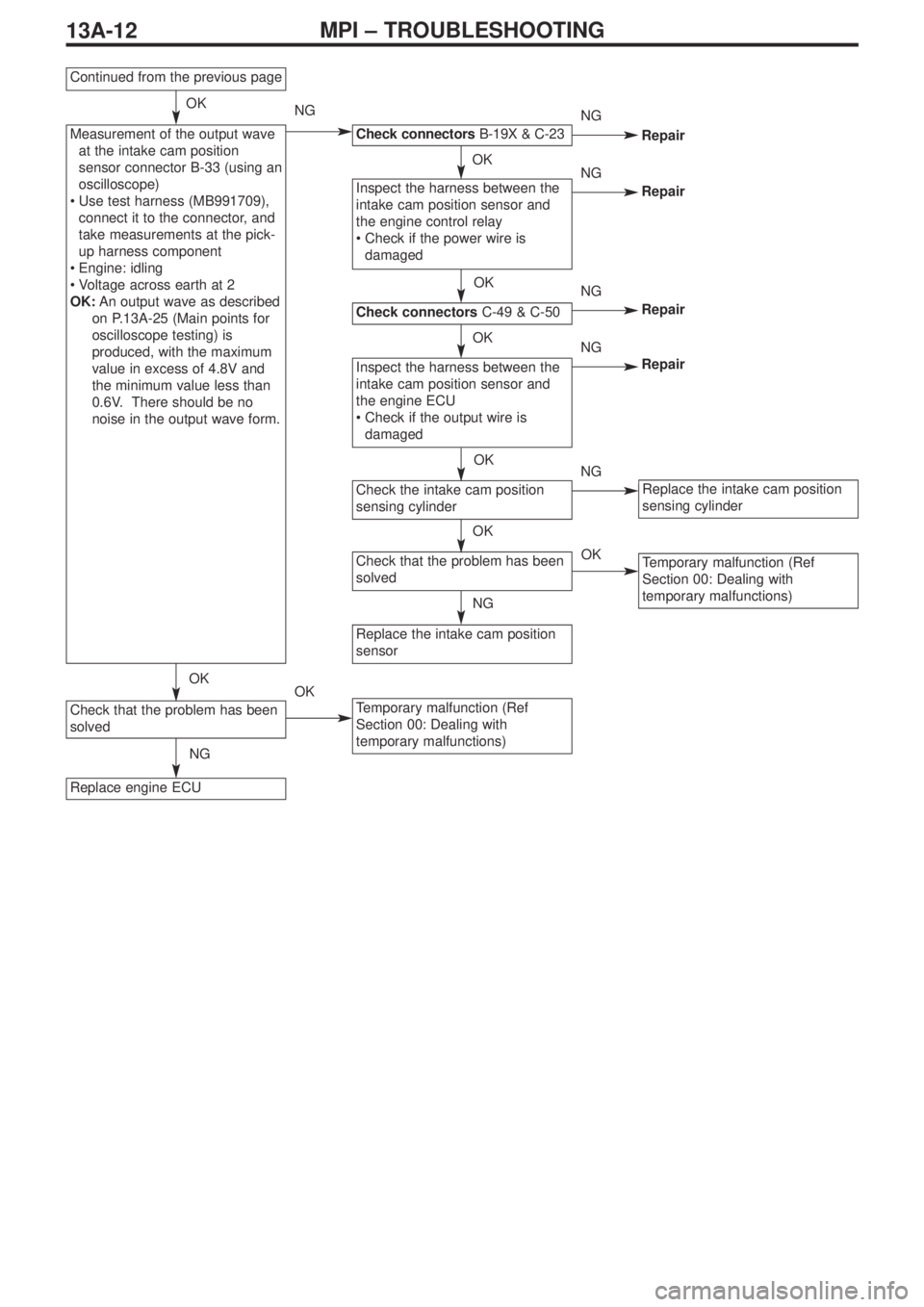
13A-12MPI – TROUBLESHOOTING
Continued from the previous page
Check connectors B-19X & C-23
Check the intake cam position
sensing cylinder
Check that the problem has been
solved
Replace the intake cam position
sensor
Temporary malfunction (Ref
Section 00: Dealing with
temporary malfunctions)
Replace the intake cam position
sensing cylinder
Temporary malfunction (Ref
Section 00: Dealing with
temporary malfunctions)
Inspect the harness between the
intake cam position sensor and
the engine ECU
•Check if the output wire is
damaged
Inspect the harness between the
intake cam position sensor and
the engine control relay
•Check if the power wire is
damaged
Measurement of the output wave
at the intake cam position
sensor connector B-33 (using an
oscilloscope)
•Use test harness (MB991709),
connect it to the connector, and
take measurements at the pick-
up harness component
•Engine: idling
•Voltage across earth at 2
OK:An output wave as described
on P.13A-25 (Main points for
oscilloscope testing) is
produced, with the maximum
value in excess of 4.8V and
the minimum value less than
0.6V. There should be no
noise in the output wave form.
Replace engine ECU
Check that the problem has been
solved
Check connectorsC-49 & C-50
OK
OKOK
NG
NG
OK
OK
OK
OK
OK
NG
NG
Repair
NG
Repair
NG
Repair
NG
NG
OK
Repair
Page 53 of 364
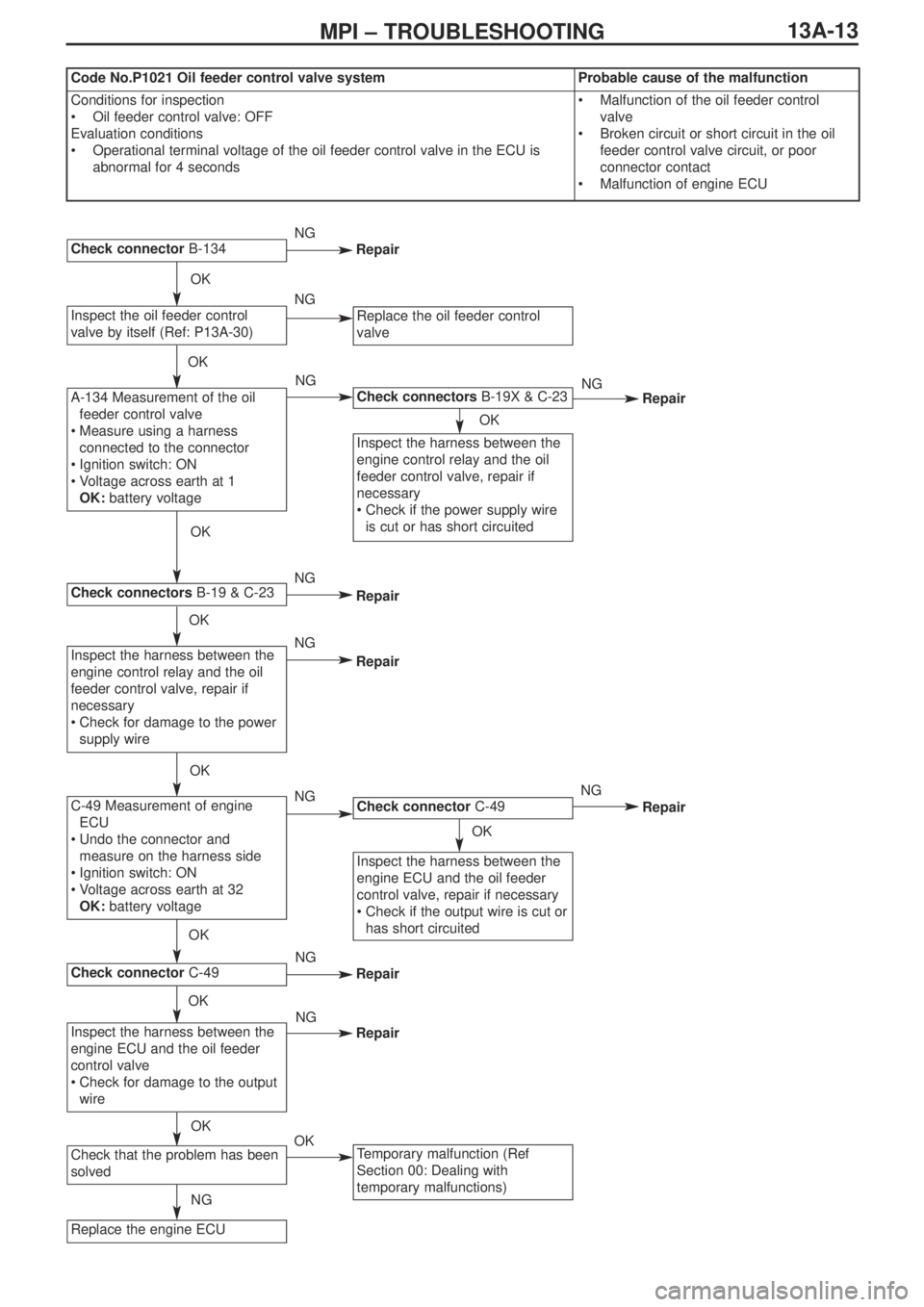
13A-13MPI – TROUBLESHOOTING
Replace the engine ECU
Check connectors B-19X & C-23
Check connector B-134
Check connectors B-19 & C-23
Check connector C-49
Check that the problem has been
solved
Inspect the oil feeder control
valve by itself (Ref: P13A-30)
Inspect the harness between the
engine control relay and the oil
feeder control valve, repair if
necessary
•Check for damage to the power
supply wire
Inspect the harness between the
engine control relay and the oil
feeder control valve, repair if
necessary
•Check if the power supply wire
is cut or has short circuited
Check connectorC-49
Inspect the harness between the
engine ECU and the oil feeder
control valve, repair if necessary
•Check if the output wire is cut or
has short circuited
Temporary malfunction (Ref
Section 00: Dealing with
temporary malfunctions)
Replace the oil feeder control
valve
A-134 Measurement of the oil
feeder control valve
•Measure using a harness
connected to the connector
•Ignition switch: ON
•Voltage across earth at 1
OK:battery voltage
C-49 Measurement of engine
ECU
•Undo the connector and
measure on the harness side
•Ignition switch: ON
•Voltage across earth at 32
OK:battery voltage
Inspect the harness between the
engine ECU and the oil feeder
control valve
•Check for damage to the output
wire
OK
NG
OKOK
OK
OK
OK
OK
OK
OK
NG
NG
NG
NG
NG
NG
NG
NG
NG
NG
OK
OK
Repair
Repair
Repair
Repair
Repair
Repair
Repair
Code No.P1021 Oil feeder control valve systemProbable cause of the malfunction
Conditions for inspection
•Oil feeder control valve: OFF
Evaluation conditions
•Operational terminal voltage of the oil feeder control valve in the ECU is
abnormal for 4 seconds•Malfunction of the oil feeder control
valve
•Broken circuit or short circuit in the oil
feeder control valve circuit, or poor
connector contact
•Malfunction of engine ECU
Page 54 of 364
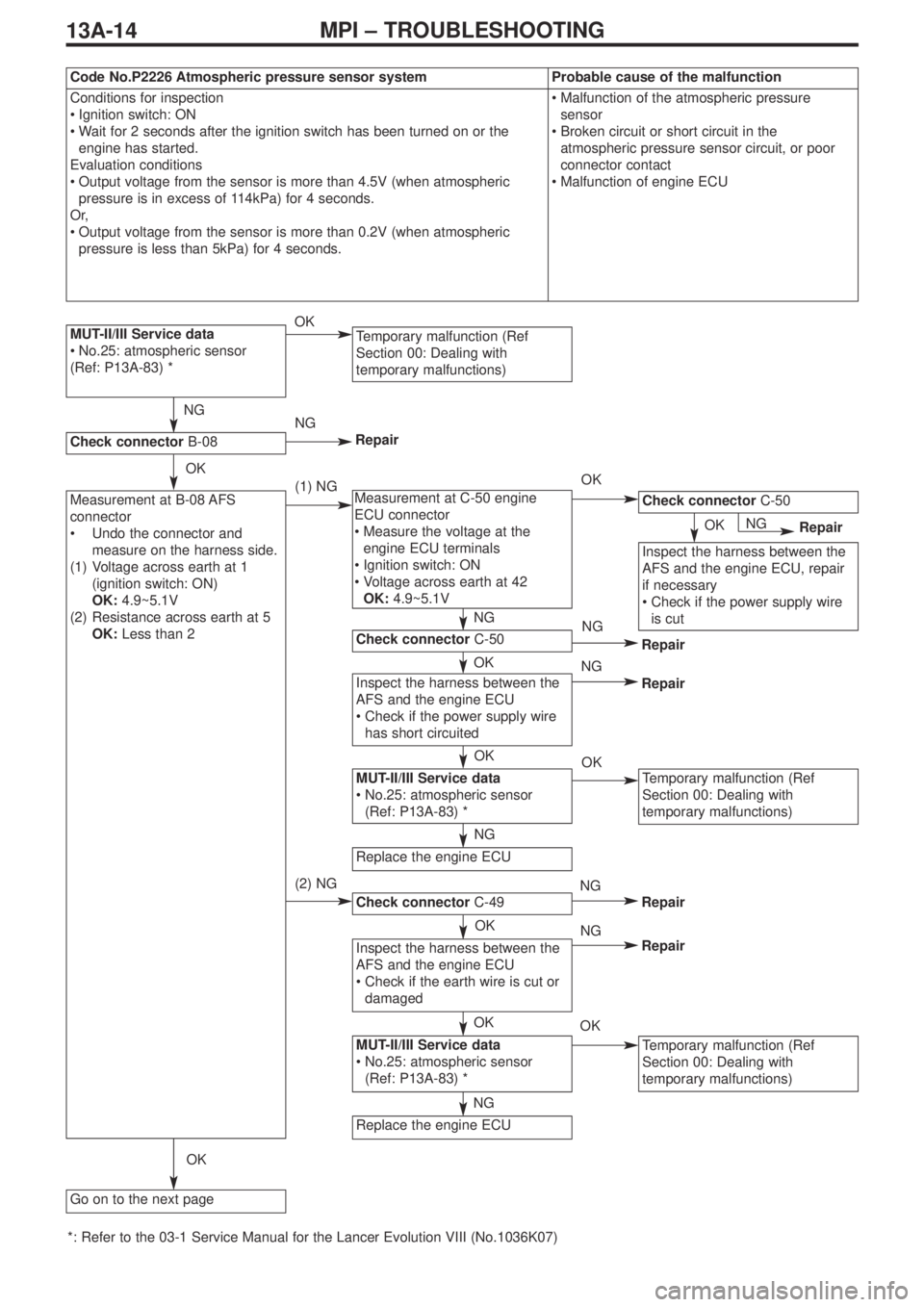
13A-14MPI – TROUBLESHOOTING
MUT-II/III Service data
•No.25: atmospheric sensor
(Ref: P13A-83) *Temporary malfunction (Ref
Section 00: Dealing with
temporary malfunctions)
Check connectorC-50
Check connectorC-50
Check connector C-49
Check connectorB-08
Go on to the next page
Inspect the harness between the
AFS and the engine ECU
•Check if the power supply wire
has short circuited
Temporary malfunction (Ref
Section 00: Dealing with
temporary malfunctions)
Temporary malfunction (Ref
Section 00: Dealing with
temporary malfunctions)
Inspect the harness between the
AFS and the engine ECU, repair
if necessary
•Check if the power supply wire
is cut
MUT-II/III Service data
•No.25: atmospheric sensor
(Ref: P13A-83) *
Inspect the harness between the
AFS and the engine ECU
•Check if the earth wire is cut or
damaged
MUT-II/III Service data
•No.25: atmospheric sensor
(Ref: P13A-83) *
Replace the engine ECU
Replace the engine ECU
Measurement at B-08 AFS
connector
•Undo the connector and
measure on the harness side.
(1) Voltage across earth at 1
(ignition switch: ON)
OK:4.9~5.1V
(2) Resistance across earth at 5
OK:Less than 2ΩMeasurement at C-50 engine
ECU connector
•Measure the voltage at the
engine ECU terminals
•Ignition switch: ON
•Voltage across earth at 42
OK:4.9~5.1V
*: Refer to the 03-1 Service Manual for the Lancer Evolution VIII (No.1036K07)
Code No.P2226 Atmospheric pressure sensor systemProbable cause of the malfunction
Conditions for inspection
•Ignition switch: ON
•Wait for 2 seconds after the ignition switch has been turned on or the
engine has started.
Evaluation conditions
•Output voltage from the sensor is more than 4.5V (when atmospheric
pressure is in excess of 114kPa) for 4 seconds.
Or,
•Output voltage from the sensor is more than 0.2V (when atmospheric
pressure is less than 5kPa) for 4 seconds.•Malfunction of the atmospheric pressure
sensor
•Broken circuit or short circuit in the
atmospheric pressure sensor circuit, or poor
connector contact
•Malfunction of engine ECU
NG
OK
OK
NG
(1) NG
(2) NG
OK
Repair
Repair
Repair
Repair
OK
NG
OK
OK
NG
OK
OK
NG
OK
OK
NG
NG
NG
NG
OKNGRepair
Repair
Page 55 of 364
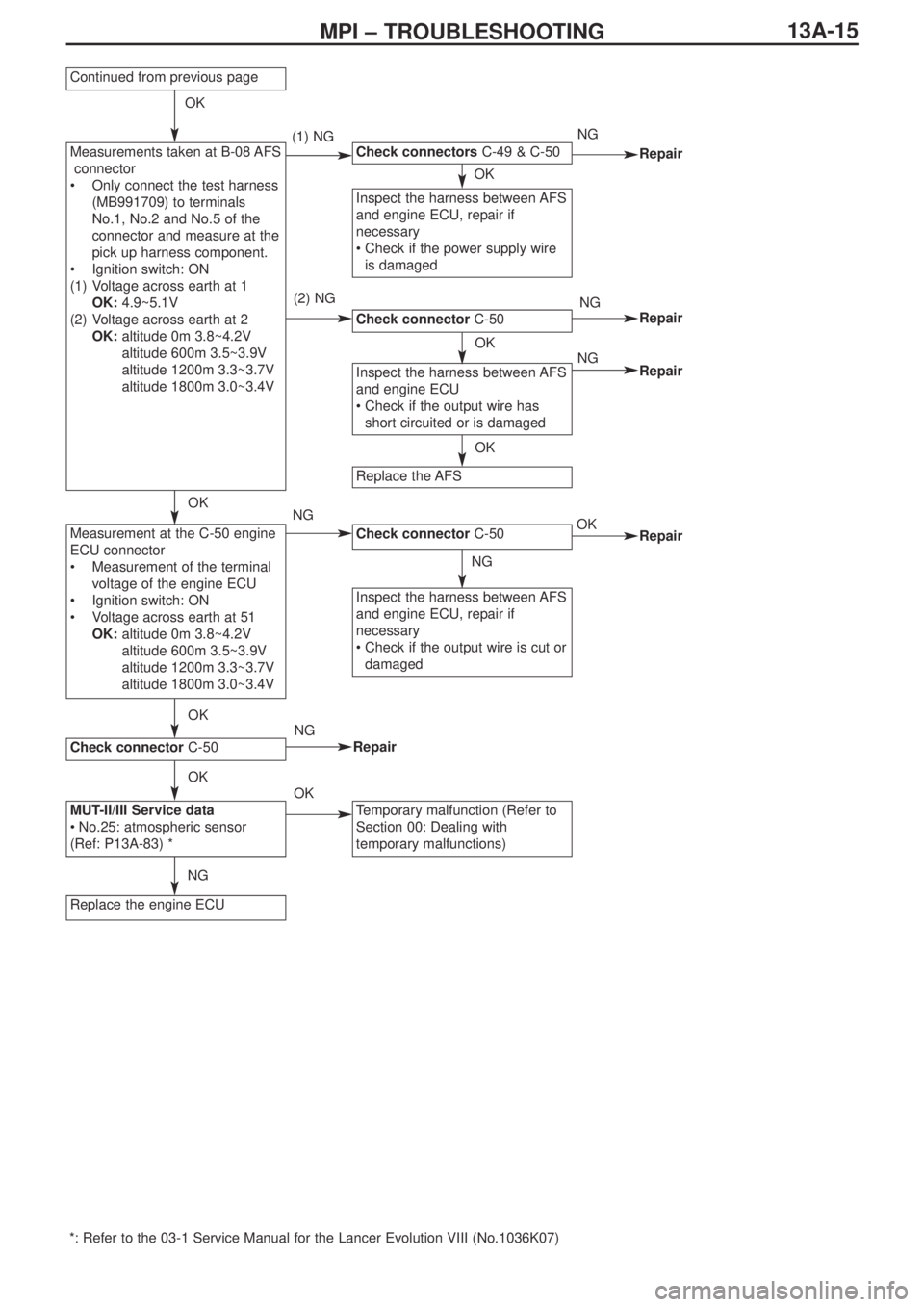
13A-15MPI – TROUBLESHOOTING
Continued from previous page
Measurements taken at B-08 AFS
connector
•Only connect the test harness
(MB991709) to terminals
No.1, No.2 and No.5 of the
connector and measure at the
pick up harness component.
•Ignition switch: ON
(1) Voltage across earth at 1
OK:4.9~5.1V
(2) Voltage across earth at 2
OK:altitude 0m 3.8~4.2V
altitude 600m 3.5~3.9V
altitude 1200m 3.3~3.7V
altitude 1800m 3.0~3.4V
*: Refer to the 03-1 Service Manual for the Lancer Evolution VIII (No.1036K07)
Replace the AFS
Check connectorC-50
Replace the engine ECU
Inspect the harness between AFS
and engine ECU, repair if
necessary
•Check if the output wire is cut or
damaged
Temporary malfunction (Refer to
Section 00: Dealing with
temporary malfunctions)
Check connectorsC-49 & C-50
Inspect the harness between AFS
and engine ECU
•Check if the output wire has
short circuited or is damaged
Inspect the harness between AFS
and engine ECU, repair if
necessary
•Check if the power supply wire
is damaged
MUT-II/III Service data
•No.25: atmospheric sensor
(Ref: P13A-83) *
Measurement at the C-50 engine
ECU connector
•Measurement of the terminal
voltage of the engine ECU
•Ignition switch: ON
•Voltage across earth at 51
OK:altitude 0m 3.8~4.2V
altitude 600m 3.5~3.9V
altitude 1200m 3.3~3.7V
altitude 1800m 3.0~3.4V
Check connectorC-50
Check connectorC-50
OK
OK
OK
OK
OK
NG
(1) NG
(2) NG
NG
NG
OK
NG
NG
NG
OK
OK
OK
NG
Repair
Repair
Repair
Repair
Repair
Page 56 of 364
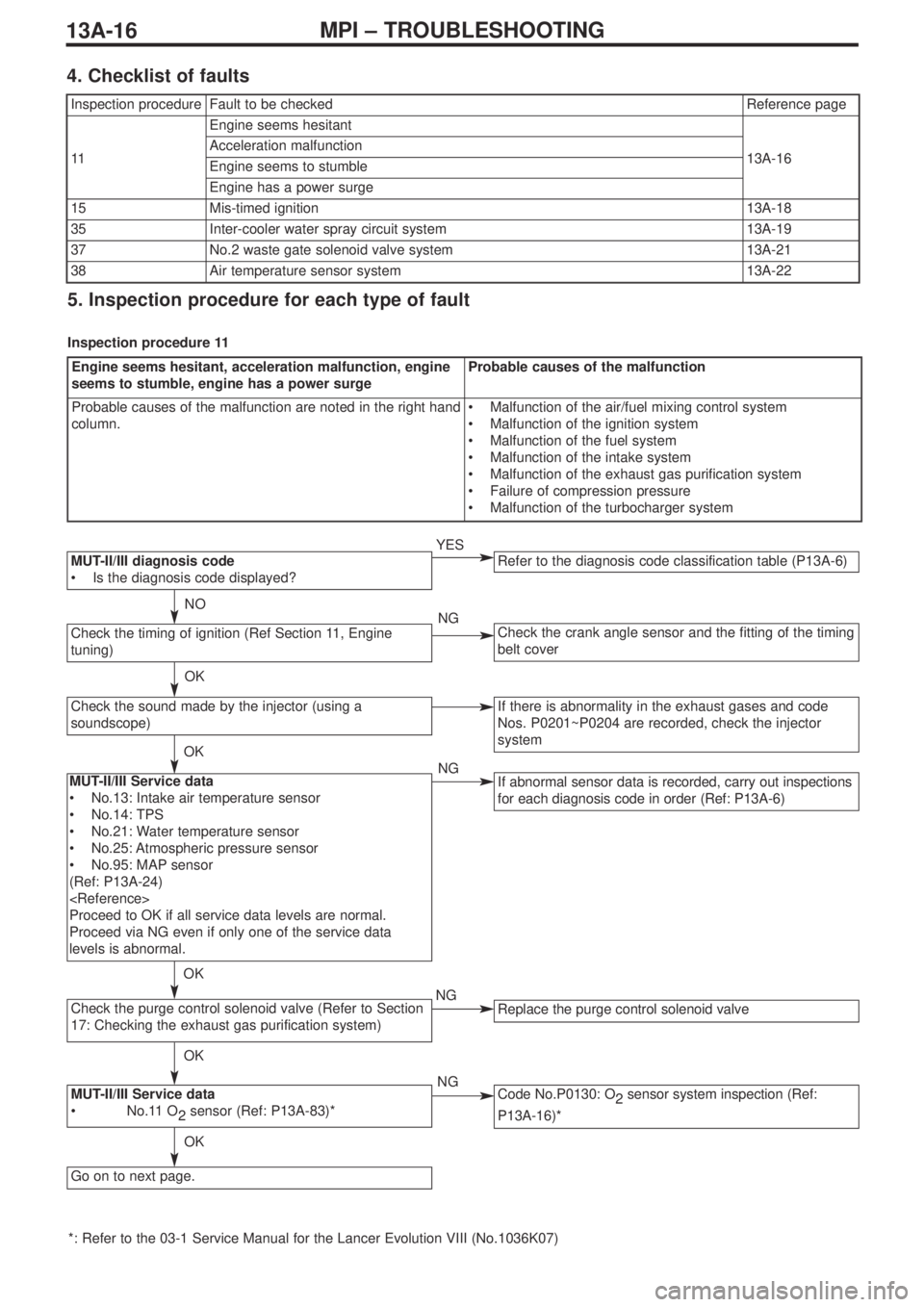
13A-16MPI – TROUBLESHOOTING
Check the purge control solenoid valve (Refer to Section
17: Checking the exhaust gas purification system)
MUT-II/III Service data
•No.11 O
2sensor (Ref: P13A-83)*
Refer to the diagnosis code classification table (P13A-6)MUT-II/III diagnosis code
•Is the diagnosis code displayed?
Check the timing of ignition (Ref Section 11, Engine
tuning)
Check the sound made by the injector (using a
soundscope)
Check the crank angle sensor and the fitting of the timing
belt cover
If there is abnormality in the exhaust gases and code
Nos. P0201~P0204 are recorded, check the injector
system
If abnormal sensor data is recorded, carry out inspections
for each diagnosis code in order (Ref: P13A-6)
Replace the purge control solenoid valve
Code No.P0130: O
2sensor system inspection (Ref:
P13A-16)*
Go on to next page.
MUT-II/III Service data
•No.13: Intake air temperature sensor
•No.14: TPS
•No.21: Water temperature sensor
•No.25: Atmospheric pressure sensor
•No.95: MAP sensor
(Ref: P13A-24)
Proceed to OK if all service data levels are normal.
Proceed via NG even if only one of the service data
levels is abnormal.
*: Refer to the 03-1 Service Manual for the Lancer Evolution VIII (No.1036K07)
NO
OK
OK
OK
OK
OK
YES
NG
NG
NG
NG
Inspection procedureFault to be checkedReference page
11
Engine seems hesitant
13A-16Acceleration malfunction
Engine seems to stumble
Engine has a power surge
15Mis-timed ignition13A-18
35Inter-cooler water spray circuit system13A-19
37No.2 waste gate solenoid valve system13A-21
38Air temperature sensor system13A-22
Engine seems hesitant, acceleration malfunction, engine
seems to stumble, engine has a power surgeProbable causes of the malfunction
Probable causes of the malfunction are noted in the right hand
column.•Malfunction of the air/fuel mixing control system
•Malfunction of the ignition system
•Malfunction of the fuel system
•Malfunction of the intake system
•Malfunction of the exhaust gas purification system
•Failure of compression pressure
•Malfunction of the turbocharger system
5. Inspection procedure for each type of fault
Inspection procedure 11
4. Checklist of faults
Page 57 of 364
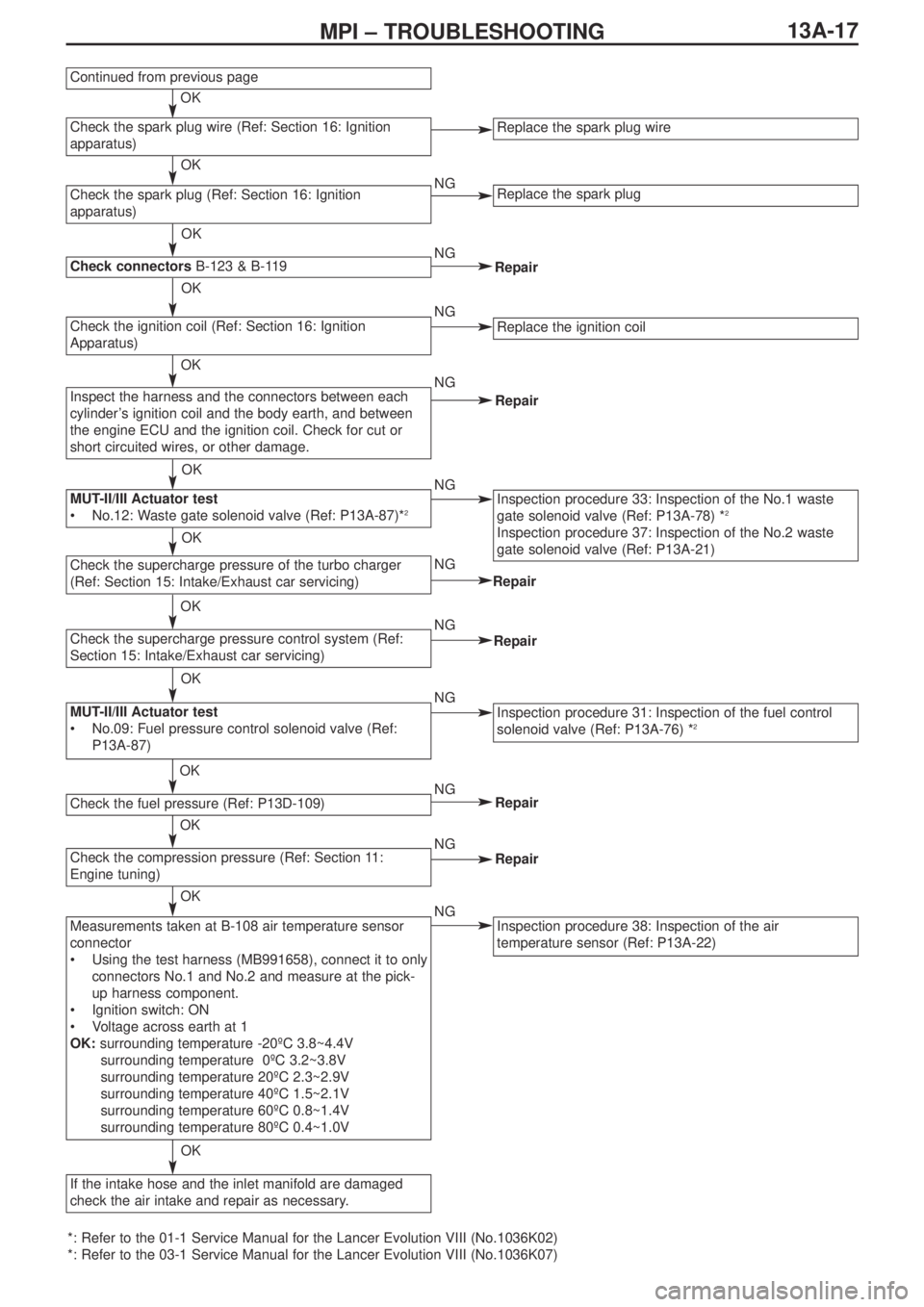
13A-17MPI – TROUBLESHOOTING
*: Refer to the 01-1 Service Manual for the Lancer Evolution VIII (No.1036K02)
*: Refer to the 03-1 Service Manual for the Lancer Evolution VIII (No.1036K07)
Repair
Repair
Repair
Repair
Repair
Repair
Continued from previous page
Replace the spark plug wire
Replace the spark plug
Replace the ignition coil
Inspection procedure 33: Inspection of the No.1 waste
gate solenoid valve (Ref: P13A-78) *2
Inspection procedure 37: Inspection of the No.2 waste
gate solenoid valve (Ref: P13A-21)
Inspection procedure 31: Inspection of the fuel control
solenoid valve (Ref: P13A-76) *2
Inspection procedure 38: Inspection of the air
temperature sensor (Ref: P13A-22)
Check the spark plug wire (Ref: Section 16: Ignition
apparatus)
Check the spark plug (Ref: Section 16: Ignition
apparatus)
Check connectors B-123 & B-119
Check the ignition coil (Ref: Section 16: Ignition
Apparatus)
Inspect the harness and the connectors between each
cylinder’s ignition coil and the body earth, and between
the engine ECU and the ignition coil. Check for cut or
short circuited wires, or other damage.
MUT-II/III Actuator test
•No.12: Waste gate solenoid valve (Ref: P13A-87)*2
Check the supercharge pressure of the turbo charger
(Ref: Section 15: Intake/Exhaust car servicing)
Check the supercharge pressure control system (Ref:
Section 15: Intake/Exhaust car servicing)
MUT-II/III Actuator test
•No.09: Fuel pressure control solenoid valve (Ref:
P13A-87)
Check the fuel pressure (Ref: P13D-109)
Check the compression pressure (Ref: Section 11:
Engine tuning)
If the intake hose and the inlet manifold are damaged
check the air intake and repair as necessary.
Measurements taken at B-108 air temperature sensor
connector
•Using the test harness (MB991658), connect it to only
connectors No.1 and No.2 and measure at the pick-
up harness component.
•Ignition switch: ON
•Voltage across earth at 1
OK:surrounding temperature -20ºC 3.8~4.4V
surrounding temperature 0ºC 3.2~3.8V
surrounding temperature 20ºC 2.3~2.9V
surrounding temperature 40ºC 1.5~2.1V
surrounding temperature 60ºC 0.8~1.4V
surrounding temperature 80ºC 0.4~1.0V
OK
OK
OK
OK
OK
OK
OK
OK
OK
OK
OK
OK
OK
NG
NG
NG
NG
NG
NG
NG
NG
NG
NG
NG
Page 58 of 364
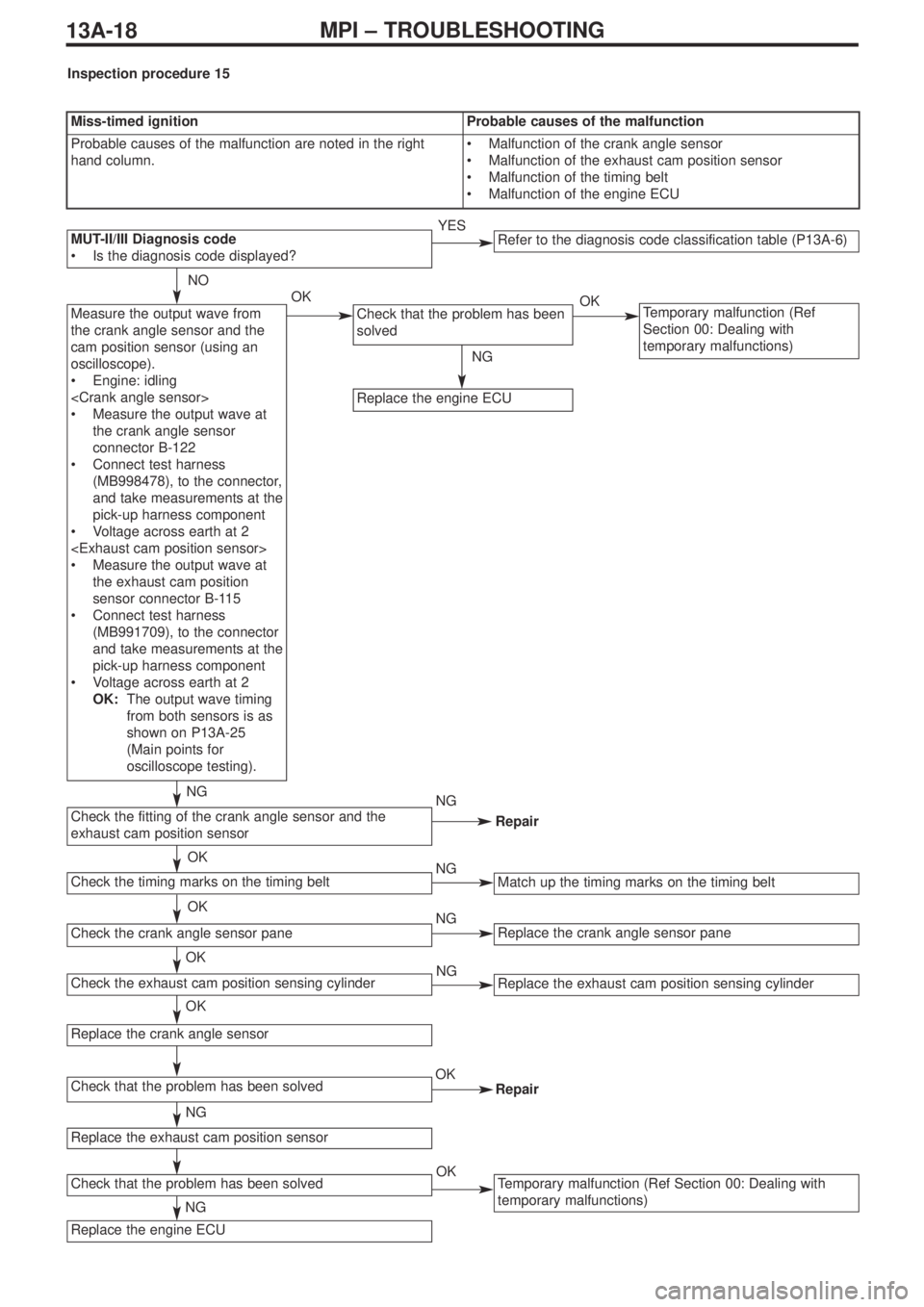
13A-18MPI – TROUBLESHOOTING
Measure the output wave from
the crank angle sensor and the
cam position sensor (using an
oscilloscope).
•Engine: idling
•Measure the output wave at
the crank angle sensor
connector B-122
•Connect test harness
(MB998478), to the connector,
and take measurements at the
pick-up harness component
•Voltage across earth at 2
•Measure the output wave at
the exhaust cam position
sensor connector B-115
•Connect test harness
(MB991709), to the connector
and take measurements at the
pick-up harness component
•Voltage across earth at 2
OK:The output wave timing
from both sensors is as
shown on P13A-25
(Main points for
oscilloscope testing).Check that the problem has been
solvedTemporary malfunction (Ref
Section 00: Dealing with
temporary malfunctions)
Replace the engine ECU
NO
OK
NG
OK
NG
NG
NG
Repair
Miss-timed ignitionProbable causes of the malfunction
Probable causes of the malfunction are noted in the right
hand column.•Malfunction of the crank angle sensor
•Malfunction of the exhaust cam position sensor
•Malfunction of the timing belt
•Malfunction of the engine ECU
Inspection procedure 15
Refer to the diagnosis code classification table (P13A-6)MUT-II/III Diagnosis code
•Is the diagnosis code displayed?YES
Repair
Replace the crank angle sensor pane
Match up the timing marks on the timing belt
Replace the exhaust cam position sensing cylinder
Temporary malfunction (Ref Section 00: Dealing with
temporary malfunctions)
Check the exhaust cam position sensing cylinder
Check the fitting of the crank angle sensor and the
exhaust cam position sensor
Check the timing marks on the timing belt
Check the crank angle sensor pane
Replace the crank angle sensor
Check that the problem has been solved
Replace the exhaust cam position sensor
Check that the problem has been solved
Replace the engine ECU
OK
OK
OK
NG
OK
NG
NG
NG
OK
OK
Page 59 of 364

13A-19MPI – TROUBLESHOOTING
Check the operation of the inter-
cooler water spray
•Ignition switch: ON
•Inter-cooler water spray
switch (manual): ON
OK:Inter-cooler water spray
operates
Check the operation of the inter-
cooler water spray
•Undo the engine ECU
connector C-50, and earth
terminal 56.
•Ignition switch: ON
OK:Inter-cooler water spray
operates
Check connector:C-220
Check the inter-cooler water
spray relay (Refer to Section 15:
Intake/Exhaust)
Go on to the next page
Measure at the inter-cooler water
spray switch connector D-32
•Undo the connector and
measure on the harness side
•Ignition switch: ON
•Voltage across earth at 5
OK:battery voltage
Check connectors: C-22 & C-50
Check connector: D-32
Inspect the harness between the
engine ECU and the inter-cooler
water spray switch
•Check if the signal wire is cut
or has short circuited
Replace the engine ECU
Check connectors: C-22 & C-50
Measure at the inter-cooler water
spray switch connector D-32
•Undo the connector and
measure on the harness side
•Ignition switch: ON
•Voltage across earth at 3 & 5
OK:battery voltage
Replace the inter-cooler water
spray relayReplace engine ECU
Check the inter-cooler water
spray switch (Ref Section 15:
Intake/Exhaust)
Inspect the harness between the
inter-cooler water spray switch
and the engine ECU
•Check if the signal wire is
damaged
Temporary malfunction (Ref
Section 00: Dealing with
temporary malfunctions)
Check connector:D-32
Check the inter-cooler water
spray switch
(Ref Section 15: Intake/Exhaust)
Check connector:C-107
Replace the inter-cooler water
spray relayInspect the harness
between the inter-cooler water
spray switch and earth
•Check if the earth wire is cut
or damaged
Inspect the harness between the
inter-cooler water spray switch
and the engine ECU, repair if
necessary
•Check if the signal wire is
damaged
Inspect the harness between the
engine ECU and the inter-cooler
water spray switch
•Check if the signal wire is cut
or has short circuited
OK
NG
NG
OK
NG
NG
OK
OK
OK
OK
NG
OK
OK
NG
NG
Repair
Inspection procedure 35
Inter-cooler water spray circuit systemProbable causes of the malfunction
•If the inter-cooler water spray switch (manual) is turned ON, the inter-cooler
water spray manual ‘ON’ signal will be input in the engine ECU. When this
signal is received, the engine ECU will turn the inter-cooler water spray relay
ON, and will start the inter-cooler water spray motor. Water will be sprayed
into the inter-cooler to cool intake air, and filling efficiency will improve.
•If the inter-cooler water spray switch (auto) is turned ON, the inter-cooler
water spray auto ‘ON’ signal will be input in the engine ECU. When this
signal is received the engine ECU will intermittently run at a high load, it will
turn the inter-cooler water spray relay ON, and it will start the inter-cooler
water spray motor. Water will be sprayed into the inter-cooler to cool intake
air, and filling efficiency will improve.•Malfunction of the inter-cooler water
spray switch.
•Malfunction of the inter-cooler water
spray relay.
•Malfunction of the inter-cooler water
spray motor.
•Circuit break, short circuit or a faulty
connection in the inter-cooler water
spray relay circuit.
•Circuit break, short circuit or a faulty
connection in the inter-cooler water
spray switch circuit.
•Malfunction of the ignition switch.
•Malfunction of the engine ECU.
Replace the engine ECU
OKNGRepair
OKNGRepair
OKNGRepair
OKNGRepair
OKNGRepair
OKNGRepair
OKNGRepair
OKNGRepair
OKNGRepair
OKNGRepair
Repair
Page 60 of 364

13A-20MPI – TROUBLESHOOTING
Measure at the inter-cooler water
spray relay connector C-220
•Undo the connector, and
measure on the harness side
•Voltage across earth 3 and 1
(ignition switch: ON)
OK:battery voltage
Measure at the engine ECU
connector C-50
•Undo the connector, and
measure on the harness side
•Voltage across earth 56
(ignition switch: ON)
OK:battery voltage
Check connector:C-31
Inspect the harness between the
inter-cooler water spray relay and
the inter-cooler water spray motor
•Check if the power supply wire
is cut, has short circuited, or is
damaged
Inspect the harness between the
inter-cooler water spray motor
and earth
•Check if the earth wire is cut, or
damaged
Check connectors C-209,
C-210, C-201 and C-208
Inspect the harness between the
inter-cooler water spray relay and
the ignition switch
•Check if the power supply wire
is damaged
Check connectors C-22 & C-50
Inspect the harness between the
inter-cooler water spray relay and
the engine ECU
•Check if the signal wire is
damaged
Check connector:A-34
Replace the engine ECU
Check the inter-cooler water
spray motor (Ref Section 15:
Intake/Exhaust)
Check connectorsC-209, C-210, C-201 and C-208
Inspect the harness between the inter-cooler water spray
relay and the ignition switch
•Check if the power supply wire is cut or has short circuited
Continued from the previous page
Check the ignition switch (Ref to Section 54)
Check connectorsC-22 and C-208
Inspect the harness between the inter-cooler water spray
relay and the engine ECU
•Check if the signal wire is cut or has short circuited
OK
OK
OK
OK
OK
OK
OK
OK
OK
OK
OK
OK
OK
OK
OK
NGNG
NG
NGNG
NG
NG
NG
NG
NG
NG
NG
NG
NG
Repair
Repair
Repair
Repair
Repair
Repair
Repair
Repair
Repair
Repair
Repair
Repair